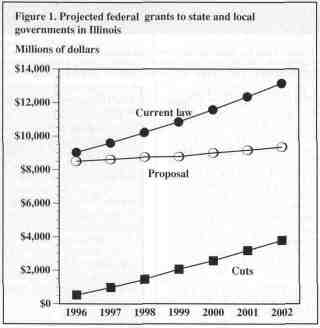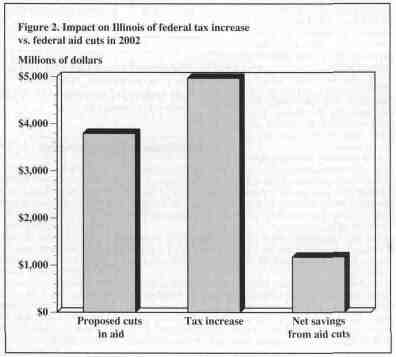Analysis by J. FRED GIERTZ
Go figure
On balance, Illinoisans might profit
from the GOP'S attempt to balance the federal budget
The tectonic shift in governmental relationships and programs promised by the massive Republican overhaul of
the U.S. budget has been attacked by opponents as a
disaster for state governments. In fact, however, states like
Illinois could experience significant economic benefits from
the congressional plan to slow the growth of federal aid to the
states in exchange for fewer restrictions on the way that federal dollars are used.
Opponents argue that huge reductions in federal aid will
force states either to raise taxes or make painful cuts in programs vital to many Illinoisans. They contend that the
increased flexibility of block grants is unlikely to compensate
fully for the reduced funding. Robert Creamer, head of the consumer group Illinois Public Action Council, told The
Associated Press: "The
congressional budget is a
thinly disguised ruse to
shift the federal deficit on
to state and local governments. For the average
Illinois family, it will
mean less health care, a
harder time sending their
children to college and
higher property tax bills."
This analysis is incomplete and unduly pessimistic, however, because it concentrates only
on the fiscal position of
the state government and
not on the relative position of citizens of the
state. Assuming that the
country genuinely wants
to balance the federal
budget over the next five
to 10 years, the only alternative to the type of cuts
approved by congressional Republicans is a major
increase in federal taxes.

Facing these choices, the people of a state such as Illinois must weigh the advantages
and disadvantages of decreased federal aid to the state compared with increased taxes that would have to be paid to the
federal government to maintain the aid. This choice has some
interesting implications for Illinois — a state that pays a disproportionate share of federal taxes and receives a relatively
small share of federal expenditures.
The silver lining
Figure 1 shows one estimate of the magnitude of the projected cuts in federal aid to state and local governments in
Illinois compared to projected aid under current law. The projected reductions would be relatively modest in 1996 (5.9 percent), but they would then increase quickly. In 2002, federal
aid would fall $3.8 billion (or 29 percent)
below the levels projected under current law.
Currently about 82 percent of federal aid in
Illinois goes to the state,
with the remaining 18
percent going directly to
local governments. Federal aid for Medicaid (a
joint federal-state program to provide medical
and nursing home care
for the poor) accounts
for the largest single
share of federal aid and
would also sustain the
largest cuts. Overall, the
loss of federal aid to the
state would result in a
loss of about 7 percent of
the state's total revenues
(including all funds) by
2002.
If there is any good
news in this story, it is
that reduced federal aid
(and other federal cut-
20/December 1995/Illinois Issues
backs) means that federal taxes will not have to be increased
substantially to balance the budget. This is a significant point
to consider for the citizens of Illinois. Estimates for 1995 suggest that Illinois' per capita federal tax burden is 15 percent
higher than the average for the United States ($5,739 vs.
$4,996). With 4.6 percent of the population, Illinois pays 5.2
percent of the federal taxes, ranking eighth highest among the
50 states. This result is understandable and not unreasonable.
Because Illinois is a high per capita income state and because
most federal taxes are based on income (and are progressive),
Illinois residents pay a disproportionate, but not necessarily
unfair, share of total federal taxes.
On the expenditure side, the results are quite different.
Illinois receives approximately 16 percent less than the U.S.
average in federal spending, ranking 40th among the states.
This ranking is also understandable since wealthier states
receive less per capita for redistribution programs than do
poorer states. In addition, Illinois is not a major producer of
military equipment, nor does it have a large number of military
bases. In regard to federal grants to state and local governments, Illinois currently receives about 4 percent of federal
grants to all state and local governments compared to its 4.6
percent of total U.S. population and 5.2 percent of total taxes
paid.
If federal taxes were increased to maintain in 2002 the current federal aid programs to all state and local governments in
the country, Illinois' share of the taxes would amount to
approximately $5 billion. This tax
increase would forestall federal aid
reductions of $3.8 billion to the state
and local governments in Illinois.
(These results are shown in Figure
2.) The net impact on the state
would be an outflow of taxes over
aid returned from Washington of
$1.2 billion. Viewed in this way, it
appears that Illinois would be better
off to accept the federal aid cuts and
to increase state and local taxes by
$3.8 billion to make up for the federal cuts.
The down side
On balance, while the "go it
alone" approach seems preferable
from a narrow perspective for
Illinois as compared with redistribution through the federal government, there are some potential negative consequences that must be considered. First, while Illinois might
gain because of its high tax-low
return position in regard to the federal government, many poorer states
would experience exactly the opposite results. For states like
Mississippi and Arkansas, the
movement to reduce grants would
generate a much greater decrease in federal aid than savings in
federal taxes. Devolution of social programs to the states,
along with reductions in aid levels, would tend to reduce the
equalizing effect that federal policy now has among states and
regions.
There would also be redistribution occurring within the
state. It is not clear the state of Illinois would choose to continue all existing programs currently paid for with federal aid
by raising state and local taxes. To the extent that program levels are not maintained in the state after federal aid reductions,
low-income citizens would suffer disproportionately, while
higher-income residents would gain by avoiding higher federal taxes. The solution to this problem, however, could be
addressed more efficiently within the state, where a dollar of
taxes collected provides a dollar of benefits to the citizens of
the state, as opposed to sending the money to Washington
where a dollar of Illinois taxes produces 75 cents in extra revenue for governments in the state.
From the Illinois perspective, this suggests that efforts to
maintain adequate services in response to federal cutbacks are
likely to be more productive than attempts to stop the changes
at the federal level — attempts that are likely to be both ill-
advised from a narrow economic standpoint and futile politically.
J. Fred Giertz is an economist in the Institute of Government and
Public Affairs at the University of Illinois at Urbana-Champaign.

December 1995/ Illinois Issues/21
Illinois Periodicals Online (IPO) is a digital imaging project at the
Northern Illinois University Libraries funded by the Illinois State Library
Sam S. Manivong, Illinois Periodicals Online Coordinator
|
|